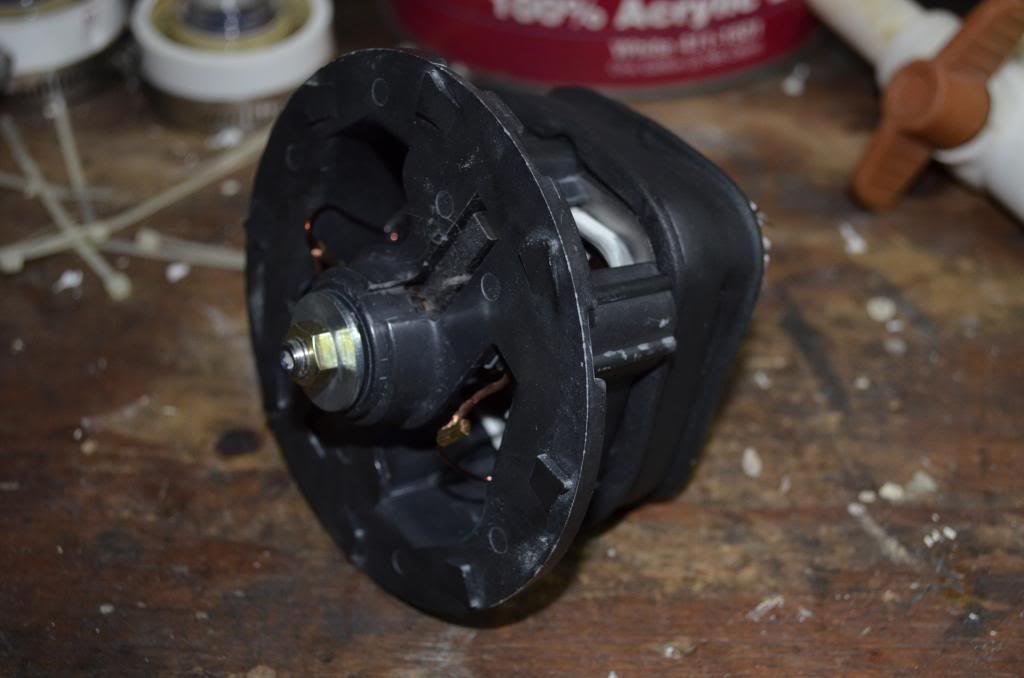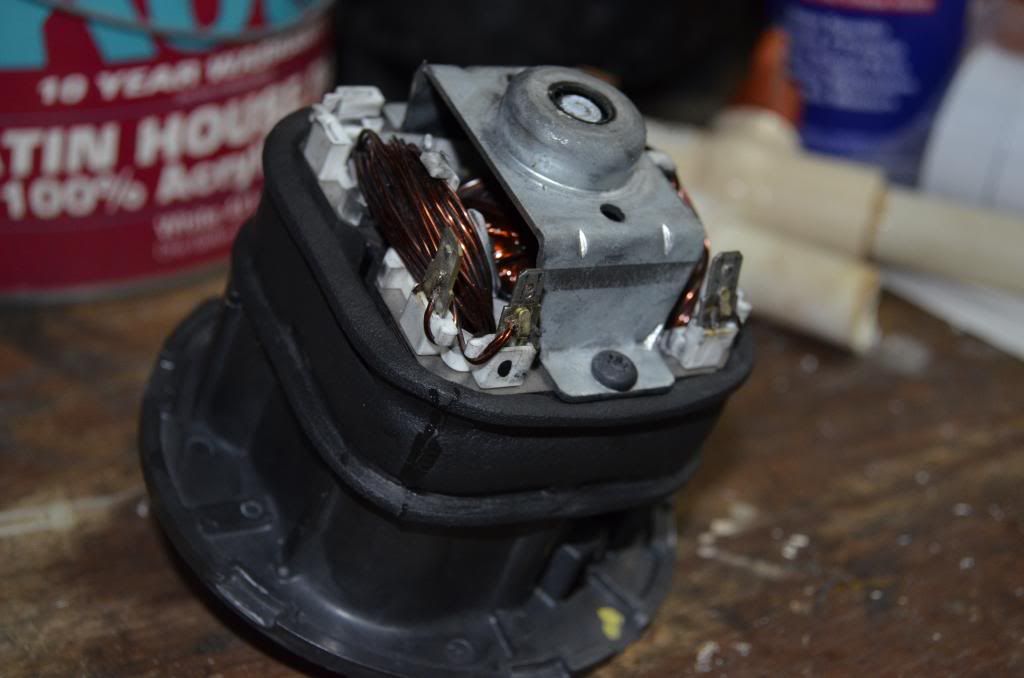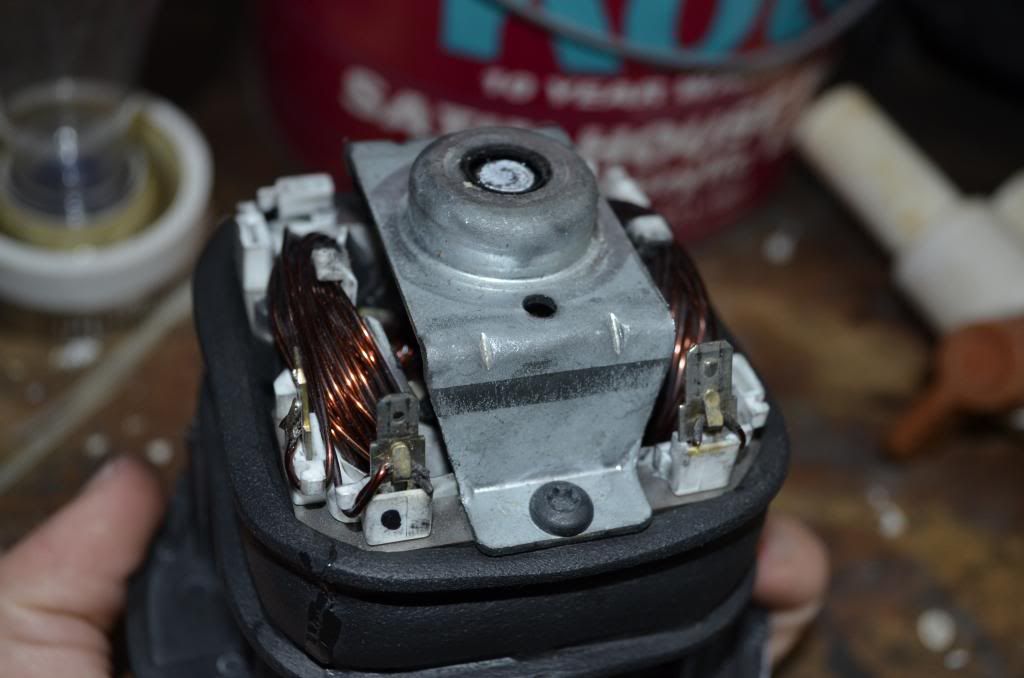Page 1 of 2
Vaccum Motor Wiring?
Posted: Sat Feb 15, 2014 9:26 pm
by Gun Freak
Alright guys so today I took apart another vacuum (5th one actually) and it prompted me to pull out all of my other motors from previous units. I might actually use the nicest one out of my collection, but I don't remember how it was wired, so I need any electronically savvy members to help me out on this one. The pictures are below. There are 2 prongs next to each other on one corner, and a single prong on the adjacent corner. I'm pretty sure only 2 wires need to be connected for it to run, because that's how all of my other motors work and they are all basically the same thing. Anybody got any ideas?
Here is the motor:

And here is what the connections look like:


Any help is appreciated!
Thanks.
Re: Vaccum Motor Wiring?
Posted: Sun Feb 16, 2014 6:35 am
by POLAND_SPUD
is the third one connected to any wire ?
If not it might be a prong for grounding
Re: Vaccum Motor Wiring?
Posted: Sun Feb 16, 2014 9:55 am
by Gun Freak
POLAND_SPUD wrote:is the third one connected to any wire ?
If not it might be a prong for grounding
If you're asking me, I don't know. On the unit I took apart yesterday, only 2 wires went to the motor, and there were only 2 prongs on the motor. Same 120 VAC, 60 Hz. This is the only motor I have with 3 prongs, and its also the only one not made in China.
If you are suggesting that it not be connected to anything, I think that is the correct way also. I also thought it might be used for grounding but I don't know if that is necessary? The vacuum I took apart yesterday only had a 2 prong plug, so there was no grounding wire anywhere in the circuit.
Re: Vaccum Motor Wiring?
Posted: Sun Feb 16, 2014 10:15 am
by jrrdw
Do you still have the control panel off the unit? Make and model #s ?
Re: Vaccum Motor Wiring?
Posted: Sun Feb 16, 2014 10:23 am
by jackssmirkingrevenge
Hah! Again your affinity for domestic appliances associated with cleaning demonstrates your basic lack of testosterone!

Gun Freak wrote:If you are suggesting that it not be connected to anything, I think that is the correct way also. I also thought it might be used for grounding but I don't know if that is necessary? The vacuum I took apart yesterday only had a 2 prong plug, so there was no grounding wire anywhere in the circuit.
If a vacuum cleaner has a plastic body then there is usually no need for a ground line.
Re: Vaccum Motor Wiring?
Posted: Sun Feb 16, 2014 12:15 pm
by Gun Freak
jackssmirkingrevenge wrote:Hah! Again your affinity for domestic appliances associated with cleaning demonstrates your basic lack of testosterone!

Gun Freak wrote:If you are suggesting that it not be connected to anything, I think that is the correct way also. I also thought it might be used for grounding but I don't know if that is necessary? The vacuum I took apart yesterday only had a 2 prong plug, so there was no grounding wire anywhere in the circuit.
If a vacuum cleaner has a plastic body then there is usually no need for a ground line.
Surely you'd change your mind if you know I was using the motor to make another lathe?!?!
And good point... I think I'm just going to do trial and error and figure out which way works... would it fry the motor if I wire it incorrectly?
jrrdw wrote:Do you still have the control panel off the unit? Make and model #s ?
By control panel do you mean circuit board? I think I actually do have the electronics still, but they won't do me any good.
Re: Vaccum Motor Wiring?
Posted: Sun Feb 16, 2014 1:28 pm
by jimmy101
Sometimes a motor will have an extra terminal that energizes only part of the main windings giving a motor with two speeds. That might be what your extra terminal is. Since vacuum makers don't usually make their own motors that feature might just be part of that standard motor and wasn't used in the actual vacuum cleaner. Or, the extra lug might be for use on 220 VAC circuits (so the same vac can be sold in places with 220VAC service simply by swapping the hot wire to the motor).
If you have forgotten which terminals were actually used you might be able to tell from the wear pattern on the lugs. Those spade lugs generally get scratched along their edges if they are ever used.
Do you have a volt-ohm meter? If the various lugs are common plus one or more windings then you should be able to figure that out based on conductivity and resistance. If one of the lugs is actually a ground then it should be conductive to say the metal frame of the motor and not conductive to any of the lugs that are connected to the windings.
Re: Vaccum Motor Wiring?
Posted: Sun Feb 16, 2014 4:42 pm
by Gun Freak
jimmy101 wrote:Sometimes a motor will have an extra terminal that energizes only part of the main windings giving a motor with two speeds. That might be what your extra terminal is. Since vacuum makers don't usually make their own motors that feature might just be part of that standard motor and wasn't used in the actual vacuum cleaner. Or, the extra lug might be for use on 220 VAC circuits (so the same vac can be sold in places with 220VAC service simply by swapping the hot wire to the motor).
Ahhh, that makes sense.
jimmy101 wrote:If you have forgotten which terminals were actually used you might be able to tell from the wear pattern on the lugs. Those spade lugs generally get scratched along their edges if they are ever used.
I actually did look at the lugs and saw that the stand-alone lug had two scratch marks on it, so I assumed a wire needed to be connected to that one. I tested it by hooking up a 19V DC power supply to the motor with a switch. First I tried wiring the power to both of the lugs next to each other, and nothing happened, so I switched one wire. One wire went to the single lug, and I left the other wire on one of the paired lugs. It ran fine. However, I was unable to confirm your hypothesis of the motor having 2 speeds, because the lugs are differently sized, and my setup only allowed me to attach the wire to the smaller one of the two. Now I am curious to see if it will run at 2 different speeds... That would be really cool. I think I remember this vacuum having 2 speeds, but I took it apart quite a while ago so I'm not sure.
jimmy101 wrote:
Do you have a volt-ohm meter? If the various lugs are common plus one or more windings then you should be able to figure that out based on conductivity and resistance. If one of the lugs is actually a ground then it should be conductive to say the metal frame of the motor and not conductive to any of the lugs that are connected to the windings.
I do have a volt-ohm meter, but I didn't think to use it. I'll try that out just for curiosity's sake.
Thank you for your help, that was the exact response I was looking for!
Re: Vaccum Motor Wiring?
Posted: Mon Feb 17, 2014 7:48 am
by jackssmirkingrevenge
Gun Freak wrote:Surely you'd change your mind if you know I was using the motor to make another lathe?!?!
http://www.ebay.com/itm/7-x-10-Precisio ... 33831369ab
Time is the most precious resource you have, use it wisely

at $10 an hour, you can earn enough money to buy the above in a week! Will you spend less time making your own lathe, and will it be better?
Re: Vaccum Motor Wiring?
Posted: Mon Feb 17, 2014 10:09 am
by Gun Freak
NEVER!!! After college Jack, after college!!

It makes no sense for me to buy one right now.
Plus, I have plans for a nice wood lathe, comparable to the ones you buy for ~200 of your finest Canadian dollars

I tested Jimmy's theory of the two lugs powering different windings- he was right.
The lug on the top supplies more power and makes the motor spin faster (the spinning motor created a frequency of music note F#)
The lug on the side was slower, making the note D.
When I connected the two lugs together with a wire and supplied power to either one, the motor still spun at the speed making an F#.
Which raises the question of- If I know the frequency of the note that the motor is making, can I tell how many RPM's it's running at? I was thinking I would have to know the number of objects in the circle that are creating the frequency, because it isn't just one thing spinning around.
So the difference isn't huge, but there is a difference. With a 3 way toggle switch I can easily switch between speeds.
Question- was I wrong by assuming that connecting the paired lugs with a wire and powering one of them is essentially the same as powering both of them from the same source?
Re: Vaccum Motor Wiring?
Posted: Mon Feb 17, 2014 3:59 pm
by jrrdw
It depends on the size and amount of windings for the magnetic field that will be made or the speed you get out of it.
Re: Vaccum Motor Wiring?
Posted: Mon Feb 17, 2014 7:21 pm
by Gun Freak
jrrdw wrote:It depends on the size and amount of windings for the magnetic field that will be made or the speed you get out of it.
I understand that, I was asking if there was a way to judge the rpm based off the frequency...
For some reason, my high speed lug just stopped working. The motor will only run when I use the low speed lug.
I made an air raid siren out of it, and I was testing it on low speed. When it worked fine on low speed, I decided to try it faster... didn't spin the motor. It just barely moves a tiny bit about 2 times per second.
Re: Vaccum Motor Wiring?
Posted: Tue Feb 18, 2014 10:37 am
by Gun Freak
Re: Vaccum Motor Wiring?
Posted: Tue Feb 18, 2014 1:56 pm
by jrrdw
It will work but running motors on low voltage can over heat them.
Re: Vaccum Motor Wiring?
Posted: Tue Feb 18, 2014 2:57 pm
by Gun Freak
jrrdw wrote:It will work but running motors on low voltage can over heat them.
Low voltage meaning...? These motors won't run on voltage <9 volts





